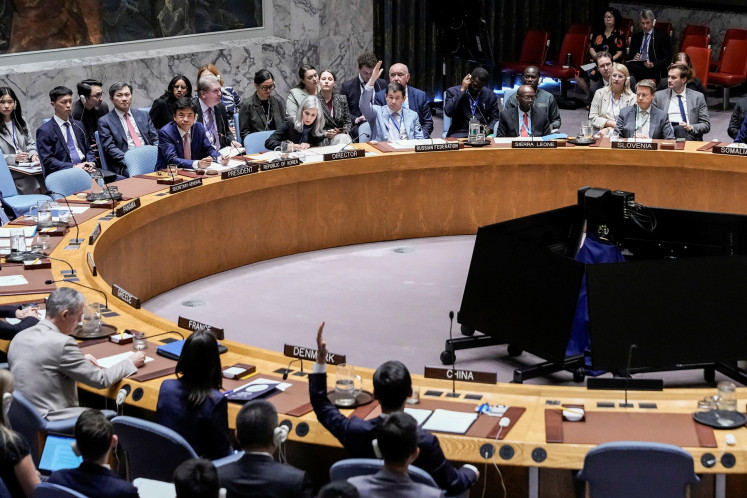Popular Reads
Top Results
Can't find what you're looking for?
View all search resultsPopular Reads
Top Results
Can't find what you're looking for?
View all search resultsUnderstanding populism in Italy — and the world
Italy is still a long way off from being an authentic liberal democracy
Change text size
Gift Premium Articles
to Anyone
I
taly is still a long way off from being an authentic liberal democracy. Just a few days ago a new government was installed that openly defines itself as populist. The two political parties that make up the Yellow-Green coalition maintain they have really understood the people’s problems, which is something the traditional political forces have not been capable of doing.
The new government also ought to have the solutions to the ills afflicting not just Italy but more generally, the world. They are ideological and emotive solutions that delude voters. The advance of Italian-style populism, just like that of Europe, is not attributable to the failure of liberalism and liberal democracies.
The responsibility must instead be sought among those in charge of power, who — in different ways, but almost always out of carefully calculated self-interest — have misunderstood the founding principles of the liberal democracies, or have been unable to grasp how they work.
They have preferred to govern by nominally maintaining the liberal-democratic concept, but effectively replacing it with a hybrid ideology, as is the case in Italy, courting the oligopolistic approach of mediaeval-style corporations and a sense of emotional solidarity.
This explains the choice of the Italian electorate who, through their protest vote, have chosen to ignore a return to economic growth, after years of depression (1.5 Gross Domestic Product [GDP] in 2017), a fall in unemployment (11.2 percent) — above all among young people (18 to 25), a better control of public debt and more substantial foreign investments.
The reasons behind the willingness to replace the old establishment with new faces, that are therefore perceived as being closer to the people, are to be sought in the intolerance of the electorate towards the impossibility of explaining and solving complex issues that are typical of the contemporary historical period.
Unemployment is falling, but the jobs market is excessively fragmented and deregulated. Salaries remain stagnant, whereas the gap between the so-called 1 percent of the population, the elites indeed, and the so-called forgotten has widened. It is a problem that is common to many European Union countries and also affects the United States of the Trump phenomenon, and parts of Asia, such as India.
Productivity in Italy has been at a standstill for too long (101.1), the lowest in the EU, as has the number of those in work (62.3 percent), compared to an indigenous population that is progressively ageing and producing increasingly fewer children (1.34). In reality Italy ought to be divided in two, the North and South, if not into four, East and West.
Despite all the difficulties the North is one of the strongest economies in Europe, notwithstanding the fact that is has more competitors today. In some areas unemployment is well below 4 percent, GDP is well above the European average, as is productivity. The South is the exact opposite, with a high level of unemployment that can only in part be explained by the black labor market.
It is within this context that elements of the majority, the Lega (green) and the 5 Star Movement (yellow) have found fertile ground. The former are responding to the frustrations of many entrepreneurs and artisans in the North, who drive the most famous army of Small and medium enterprises (SMEs) in the world, against the central government, bureaucracy and in general anyone who undermines the quietness of public and private life of peaceful small towns of the northern province.
The latter back the hard work and dreams of the South to build a sound economy that is equal to that of the North, free from corruption, Mafias, disastrous policies and insane spending.
It is from here that two profoundly different electoral programs have come originated and that have been laboriously and contradictorily united in the so-called contract for change that the new and unknown prime minister should deliver under the control of the two political movements. The aim is to please the SMEs in the North, introducing the flat tax, whilst on the other hand it is to guarantee everyone a better welfare system, through Universal Income and a review of the pension system, deemed bad for workers.
Where is the money going to come from that is going to be used to fund tax cuts, introduce the flat tax and protect everyone with a universal income? The program doesn’t explain this, other than referring to a generic cut in spending. And that’s because not even the most refined and ingenious economist would be capable of finding the resources required, without further driving up public debt and the deficit/GDP ratio that EU countries are called upon to respect.
All we can do is wait in order to judge, just as the markets are doing. They have already shown signs of being jittery, speculating on government securities and the spread between these and the German ones.
A clear idea nevertheless unites these two movements, the origins of which are Trumpian: Italy First.
The government pragmatically wants to place citizens at the heart of the agenda once again, something that previous governments, and not just in Italy, have forgotten to do.
Policies on immigration that are more pragmatic compared to the solidarism of left-wing governments and the Church of Pope Francis; a rapprochement with Putin’s Russia to surpass the sanctions that would penalize the SMEs in then north of Italy; skepticism towards the actual EU setup to be overcome by a proposal to reform the EU, about which the Yellow/Green coalition doesn’t appear to have even the vaguest idea — this demonstrating that this government’s anti-Europeanism responds to the need to have an enemy, in addition to the migrant.
The same could be said about the refusal of any policies that can be attributed in some way to the interests of the multinationals or to the more serious world of science and research. This political stance has paid off electorally because it shows citizens that it has listened to their problems and deludes them with emotive and ideological proposals that are reassuring.
I doubt, however, that it will produce any significant results. This government will simply seek short-term outcomes that can excite voters. It will fail to carry out those reforms that the country, and the EU, are in desperate need of. But, as we have seen, thanks to the tools of liberal democracy, voters will quickly backtrack and demand a new change.
The Italian situation summarized here can, in different ways, be found in many other EU countries. It ought to serve as a lesson to Asian countries to help them understand that in order to avoid populism it is necessary to diagnose the problems that time brings with it and not hide them away, and to present citizens with feasible solutions that improve coexistence, freedom and prosperity.
_______________________________________________
The writer is a contributor to Il Sole 24 Ore, the third largest paper in Italy.










